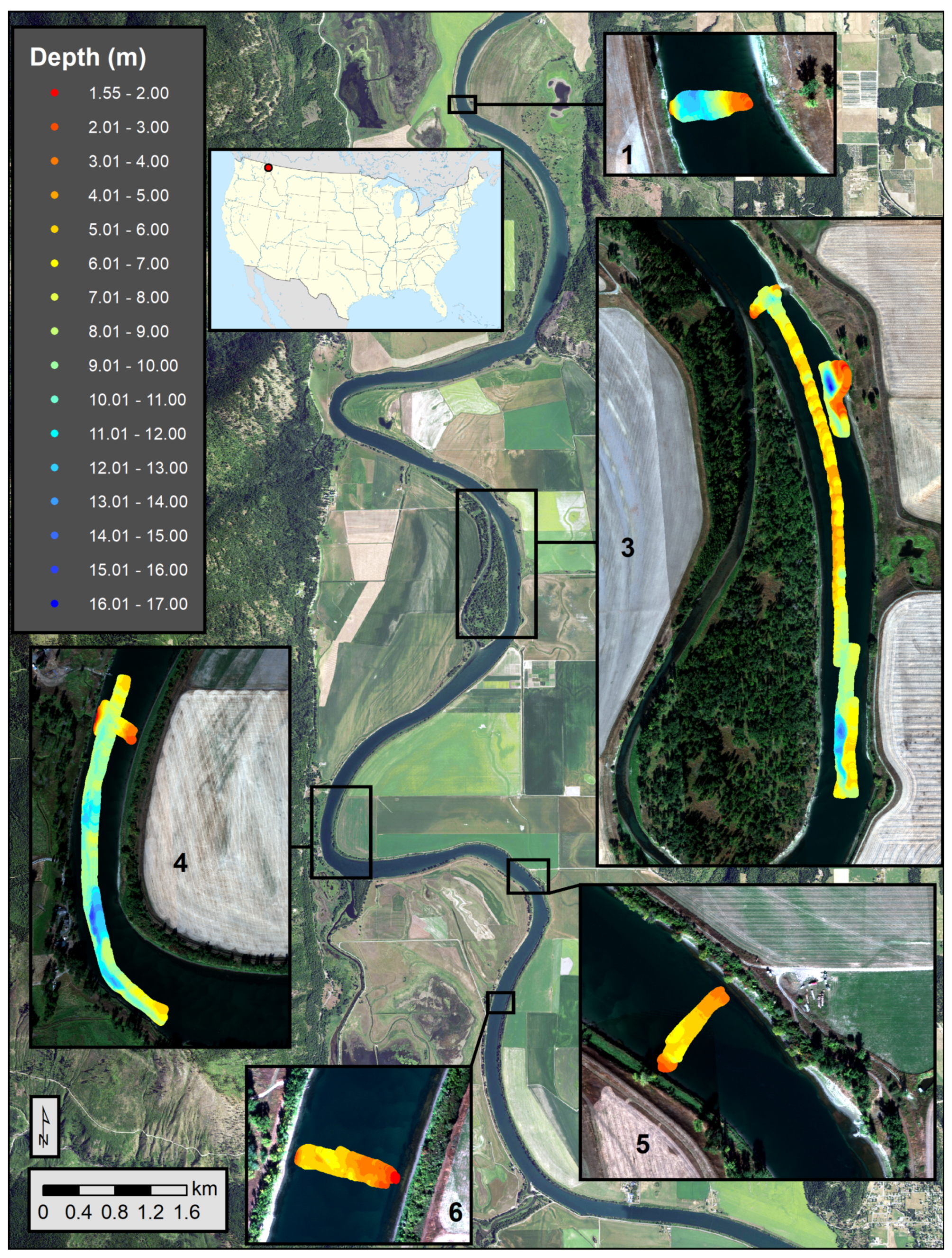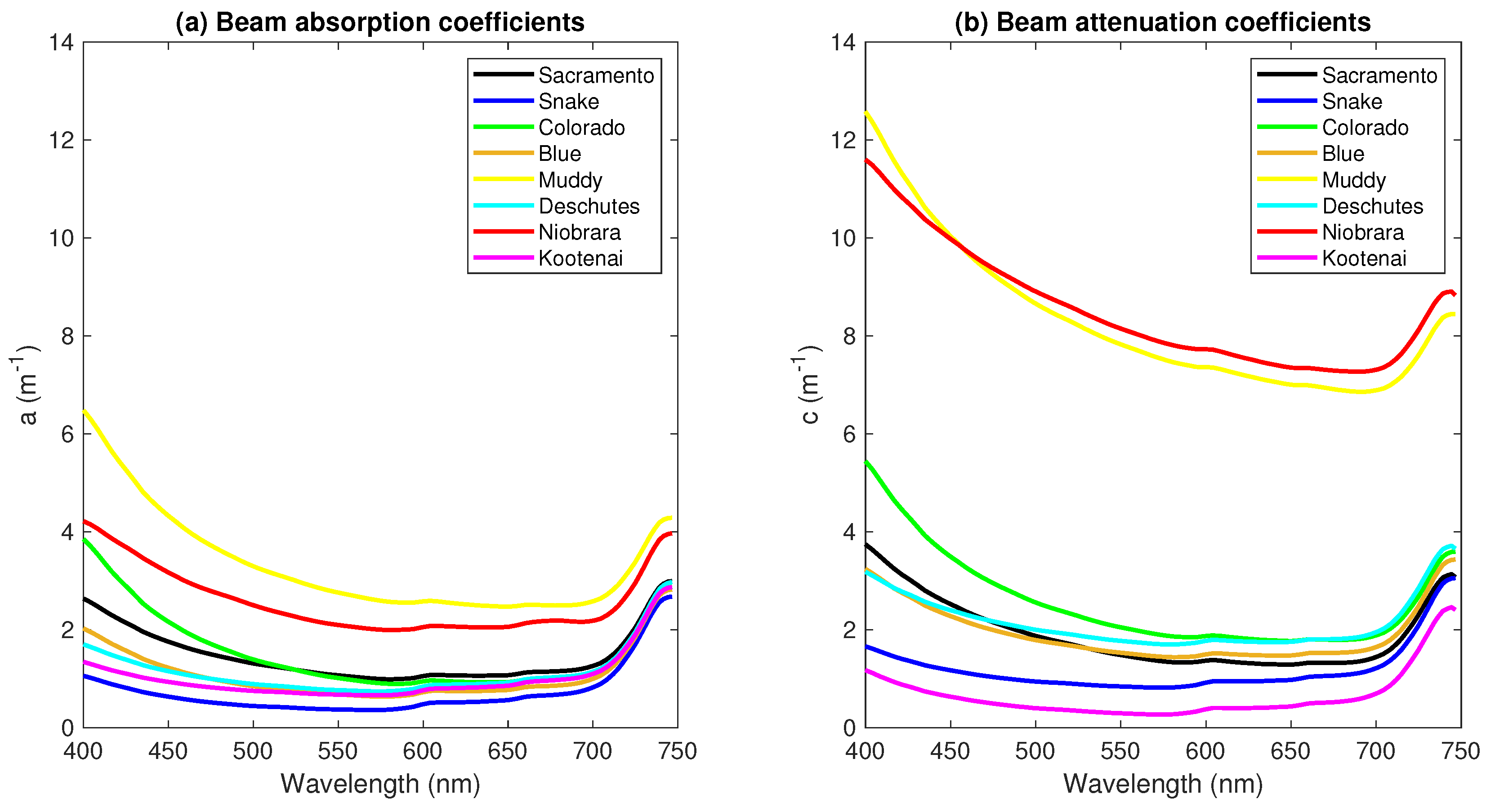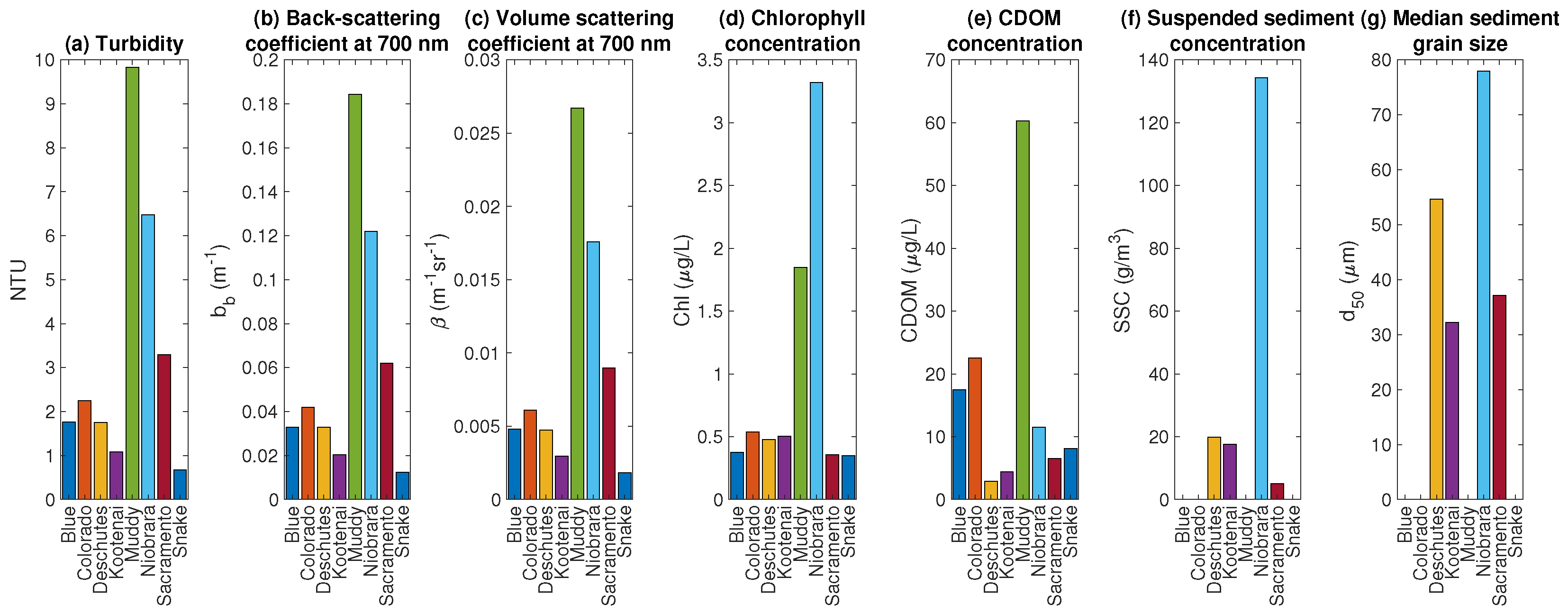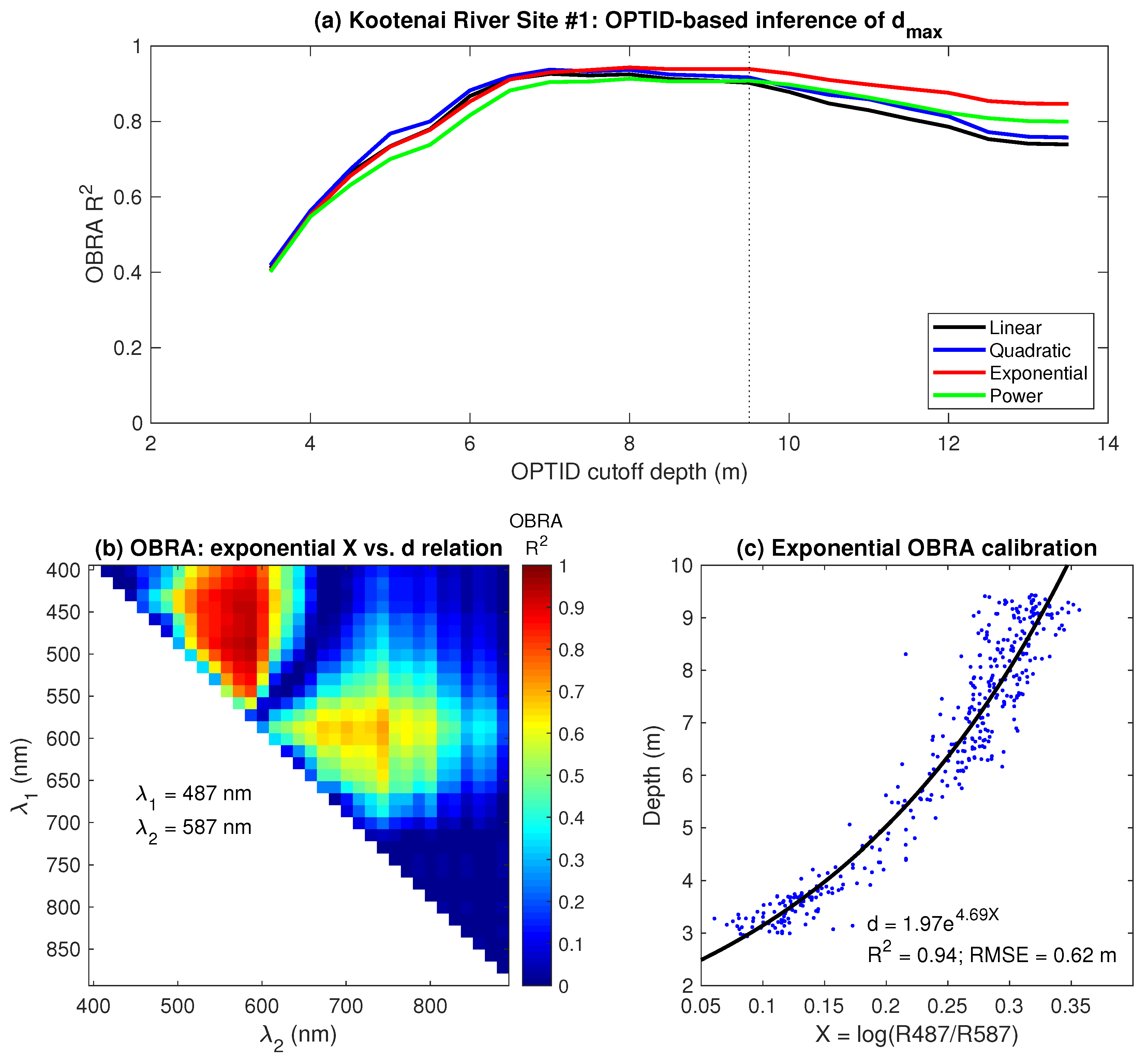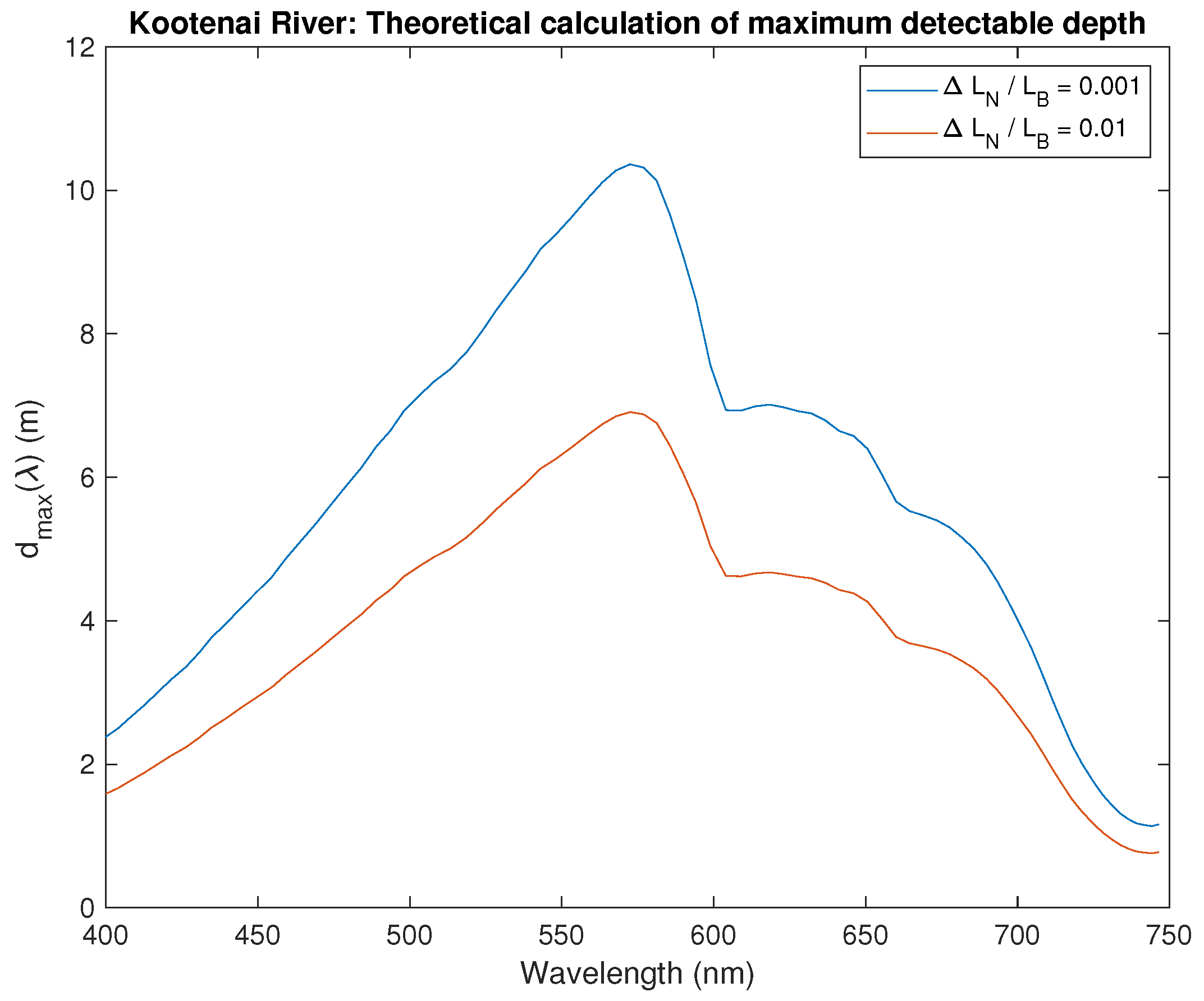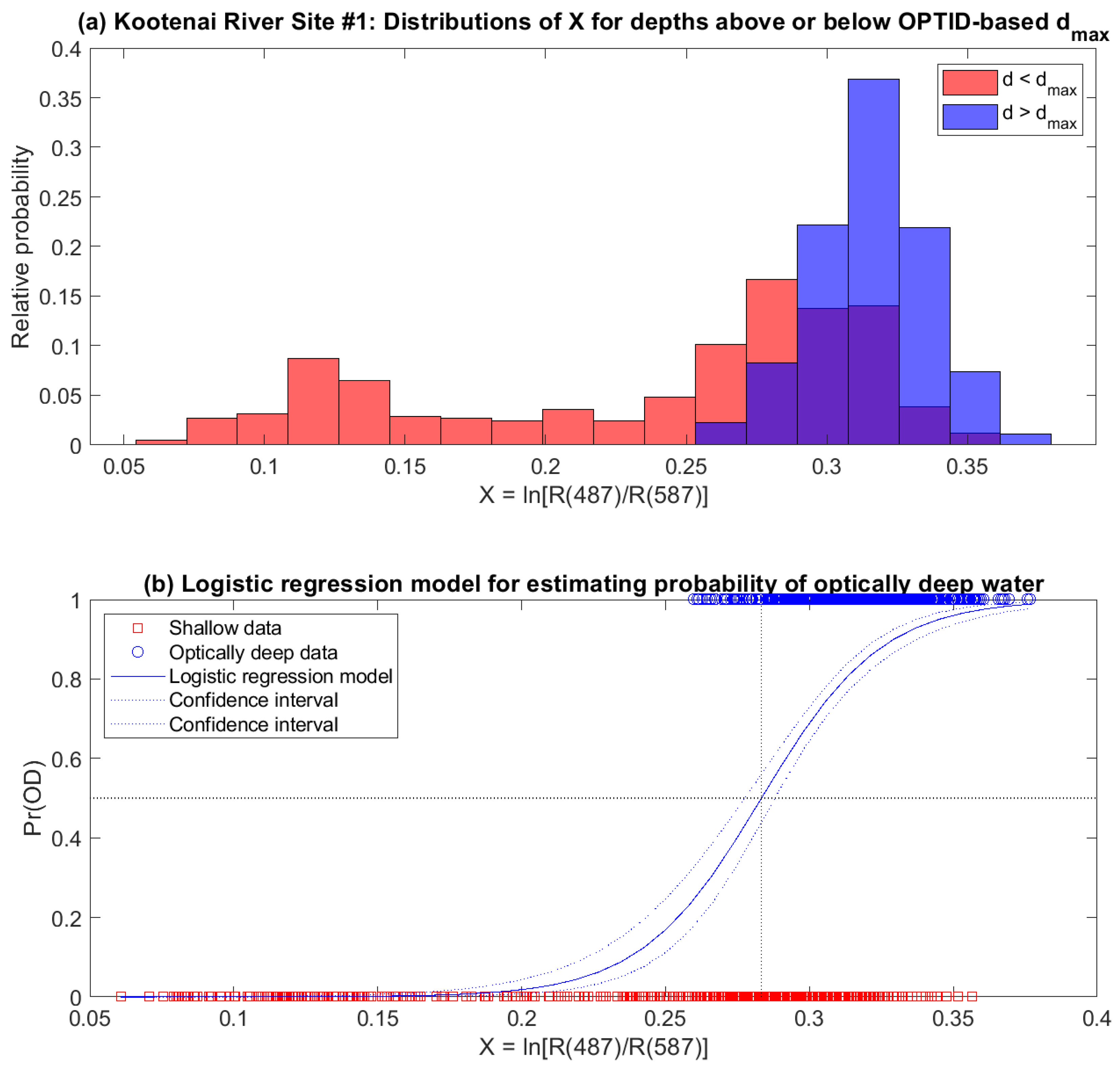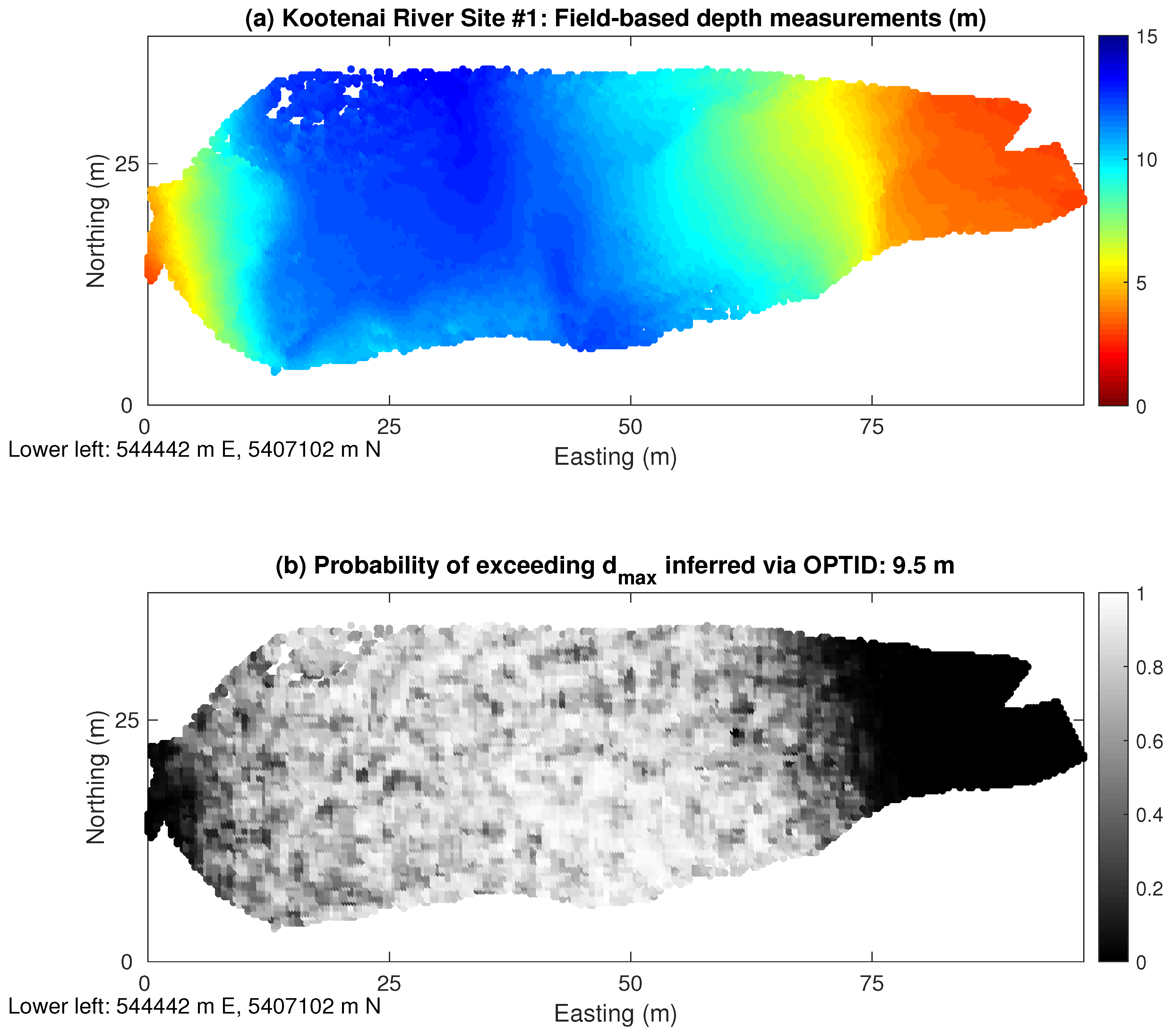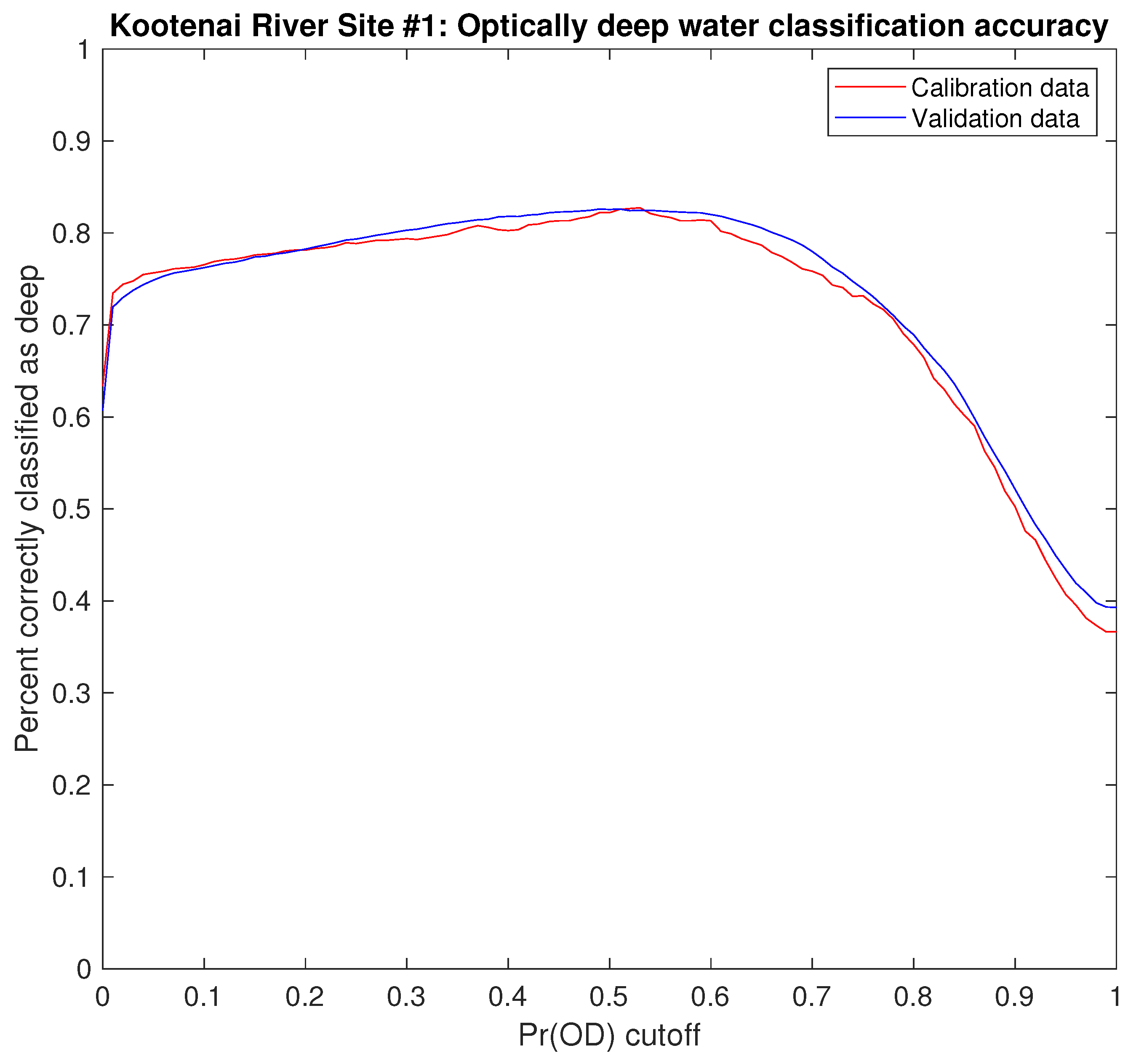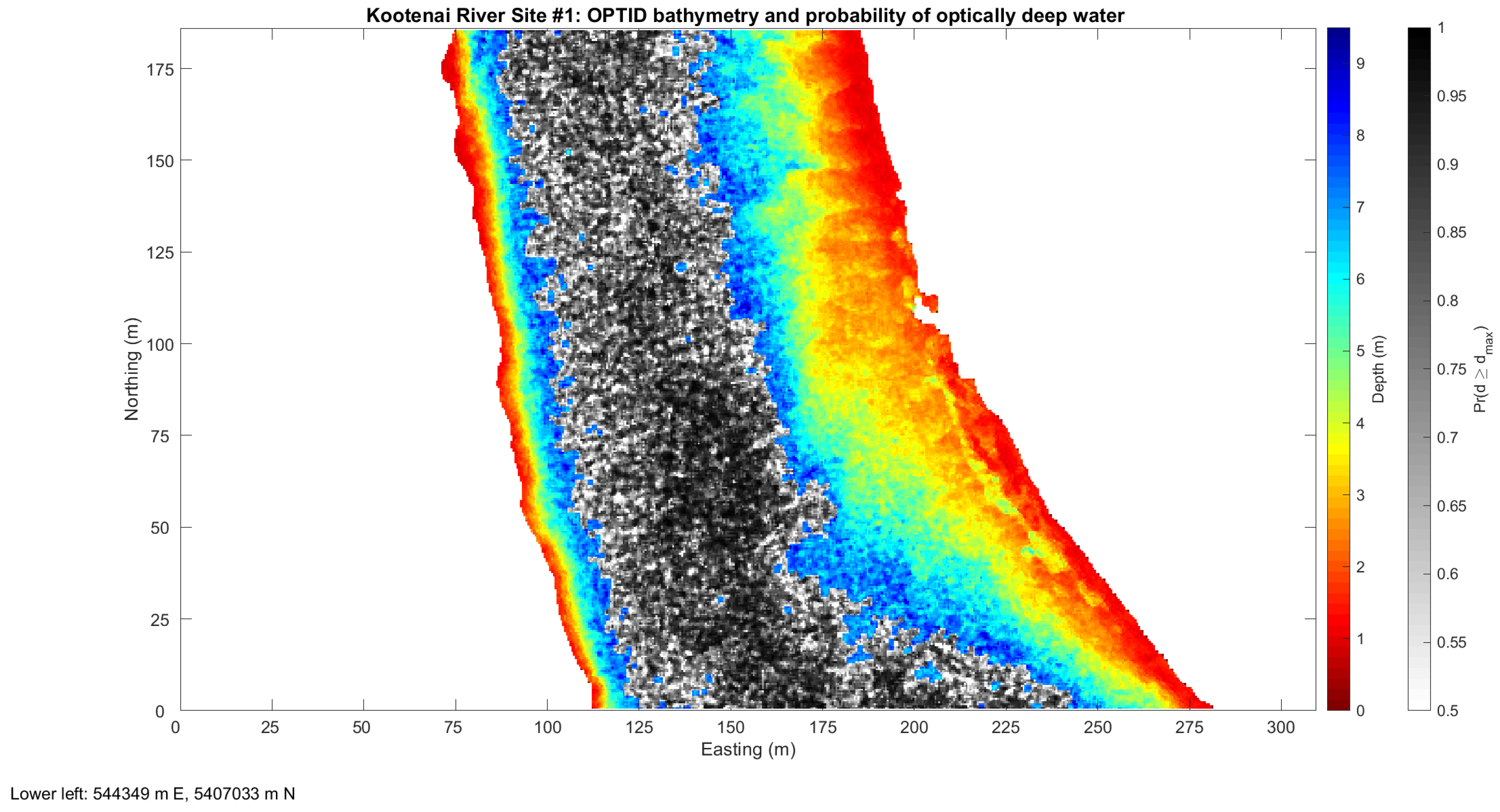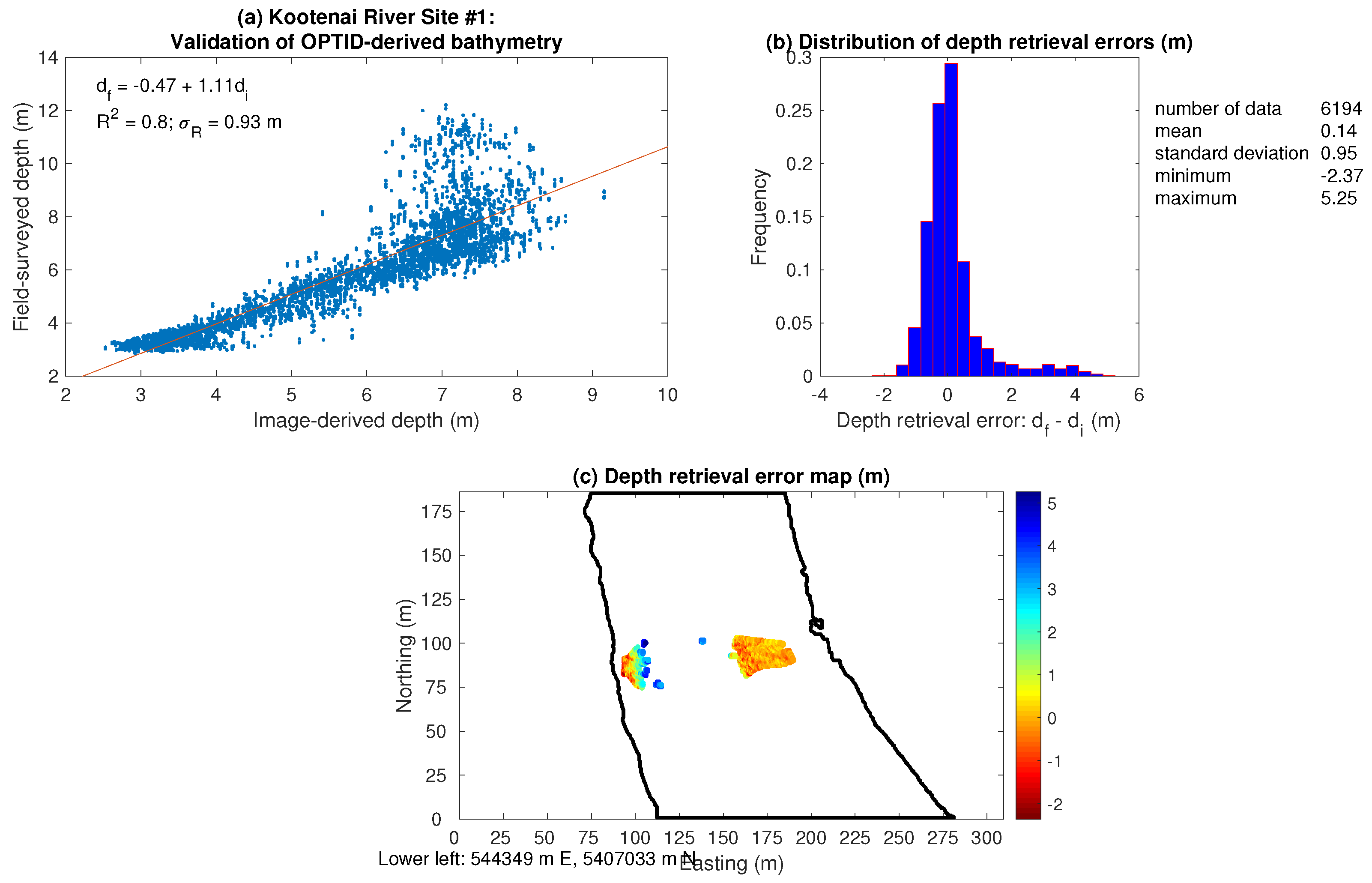3.2. Spectrally Based Depth Retrieval and Inference of the Maximum Detectable Depth
One of the primary objectives of this investigation was to further test the notion, introduced by Legleiter et al. [
24], that the maximum depth detectable by a particular sensor deployed above a specific river can be inferred by evaluating how depth retrieval accuracy varies across a range of depths. The OBRA of Progressively Truncated Input Depths (OPTID) procedure described above provides a formal mechanism for this type of analysis and was applied to MBES-derived depth measurements and CASI image spectra from each of five sites along the Kootenai River. We focus on Site #1, located at the lower end of our study area (
Figure 1), because this site consisted of a single, relatively simple, asymmetric cross section that spanned a broad range of depths and thus best illustrated the approach outlined herein, but similar analyses also were performed for each of the other sites.
The results of generalized OPTID for Site #1 are summarized in
Figure 5a, in which each solid line represents a different functional form of the relationship between
X and
d, given by Equations (
4)–(7). The OBRA
value, which serves as an index of the strength of the calibrated
X versus
d relation, rose steadily from 0.40 to 0.94 as the cutoff depth used to subsample the calibration data set increased from 3.5 m to 7 m. This result indicates that very strong, quantitative connections between depth and reflectance could be established for this site, provided that the range of depths available for calibration was sufficient. The much lower
values for the shallowest cutoff depths were a consequence of having a weaker signal of interest—variation in depth—that was obscured by the environmental and instrumental noise inherent to hyperspectral images of natural rivers. As cutoff depth increased beyond 7 m, OBRA
plateaued but remained above 0.90 for all four functional forms, suggesting that depth retrieval would be highly accurate across this range of depths. Beginning at about 9.5 m, however,
values began to decrease as deeper field observations were included in less truncated subsets of the calibration data. We thus interpreted this inflection point, marked by the dashed vertical line in
Figure 5a, as an indication of the maximum detectable depth for this site:
m.
To assess whether this empirical, image-based estimate of the maximum depth the CASI sensor could detect on the Kootenai River was realistic, we made independent, theoretical calculations of
based on field measurements of water column optical properties. More specifically, we used observed values of
(
Figure 3b) in place of
in Equation (
2) to approximate the diffuse attenuation coefficient
. We then assumed
values of 0.01 and 0.001 to calculate
following Philpot [
21] (Equation (
1)). As described above, this approach was conservative and might have lead to larger values of
and thus overestimates of the strength of attenuation by the water column, which would in turn reduce the calculated
. With this caveat in mind, the results of this analysis are summarized in
Figure 6 and substantiate the 9.5 m estimate of
inferred directly from the CASI image via OPTID. The greatest calculated value of
occurred at a green wavelength of 573 nm and was 10.4 m for the more sensitive detector with
and 6.9 m for an instrument with a lower radiometric resolution and
. The denominator band
identified as optimal for the OPTID depth cutoff corresponding to the inferred
was slightly longer, 587 nm. At this wavelength, the calculated
values were only marginally less, 9.6 m and 6.4 m for the high- and relatively low-sensitivity detectors, respectively. Although characterizing a sensor’s noise characteristics is difficult in a complex fluvial environment [
22], these theoretical values of
are comparable to that estimated via OPTID, lending some additional credibility to the image-based approach proposed by Legleiter et al. [
24] and built upon herein.
Each point on the OPTID plot of cutoff depth versus
in
Figure 5a represents a distinct iteration of the core OBRA algorithm and we extracted the OBRA results corresponding to the inferred
of 9.5 m. This output includes the numerator and denominator bands identified as optimal by performing
X versus
d regressions for all possible wavelength combinations, which can be visualized as a matrix of
values [
11].
Figure 5b shows how the strength of exponential relations between
X and
d varied spectrally for different band ratios (i.e., versions of
X). The presence of a sizable region of bright red tones in the upper left portion of
Figure 5b indicates that pairing any blue to green numerator band (
nm) with a green denominator band between 530 and 600 nm would yield an
X versus
d relation nearly as strong (
) as that identified as optimal via OBRA. The significance of this finding is that broader bands could be used to establish robust relationships between depth and reflectance, not just a narrow range of very specific wavelengths. The wavelengths selected for the Kootenai are shorter than those used on shallower rivers such as the Snake [
6] because penetration of light into the water column is greater in the blue and green portions of the spectrum, enabling spectrally based bathymetric mapping in a deeper channel like the Kootenai.
The calibration scatter plot for the optimal band ratio is shown in
Figure 5c and suggests that the exponential relation effectively captured the curvature that occurs when depths range up to nearly 10 m (e.g., [
47]), but the
X versus
d relation was not highly nonlinear. Comparison of the different lines in
Figure 5a indicates that, although the exponential function provided the best fit, the other three model types would have yielded
values nearly as high. This result implies that the selection of a particular kind of OBRA model is not critical, either, and provides further evidence that the relationship between
X and
d is robust in a large natural river for depths up to nearly 10 m, much greater than reported in previous studies. We selected the exponential model not only because it provided the best fit in terms of
but also because this type of function avoids the artifacts that occur in shallow areas for other model types: linear
X versus
d relations tend to yield negative depth estimates along channel margins while quadratic OBRA models often predict unrealistically large depths near the banks [
17].
3.3. Logistic Regression Modeling of Optically Deep Water
Although Legleiter et al. [
24] introduced the OPTID framework and proposed that the technique could serve as an empirical means of inferring
directly from an image, that study did not provide a way to identify areas of the channel where
. An important goal of the present investigation was to build upon OPTID-based inference of
by developing a formal mechanism for distinguishing optically deep water and thus delineating gaps in bathymetric coverage. Having selected a value of
, the first step in this process involved partitioning the full, original calibration data set into two groups, a shallow subset with
and an optically deep subset with
. Pixel values at the locations of the MBES-based depth measurements used for calibration were then extracted from the
X image produced using the optimal band combination for the OBRA iteration corresponding to the selected
, 9.5 m for Kootenai River Site #1. The frequency distributions of
X for the two groups are shown in
Figure 7a. Whereas the shallow class encompassed depths from the minimum recorded along this cross section (2.85 m) up to 9.5 m and thus spanned a broad range of
X values from 0.05 to 0.35, the distribution of
X for optically deep pixels was much narrower and centered about a higher
X value of about 0.37. The two distributions thus overlapped one another, implying that distinguishing between the two classes with a a single, strict threshold value of
X might not be appropriate.
Given the potential ambiguity involved in separating optically deep from relatively shallow pixels, we employed a probabilistic approach to identifying portions of the channel with
. First, each calibration data point was assigned a value of the indicator variable
based on Equation (8), either a 0 for a shallow observation or a 1 where
. These
values were then used to fit the parameters of the binary logistic regression model given by Equation (9): the coefficients
and
. The resulting sigmoid function is plotted in
Figure 7b and shows how an input
X value is transformed into a probability,
, of observing the event
—that is, the probability of optically deep water. For the smallest values of
X less than 0.2,
is very low, but as
X increases further, the likelihood of observing optically deep water gradually increases and crosses the
threshold (indicated by the dashed horizontal line in
Figure 7b) at the
X value given by Equation (10):
in this case (dashed vertical line in
Figure 7b). For
X values greater than this cutoff, the corresponding location in the channel is more than 50% likely to be optically deep, beyond the maximum depth detectable by the CASI sensor. Also depicted in
Figure 7b are the upper and lower limits of a 95% confidence interval for the logistic regression model; the proximity of the two dashed lines suggests that the model is well-constrained by the data despite the overlapping distributions of the shallow and optically deep classes.
The purpose of the logistic regression model, once fit using the calibration data, was to delineate areas of the channel for which image-derived depth estimates would be unreliable due to the presence of optically deep water. To illustrate this procedure, we applied the logistic regression model to the MBES-based validation data for Site #1 on the Kootenai River. Due to the high density of the MBES survey, 95% of the original data were reserved for validation, providing detailed, nearly continuous coverage of the transect (
Figure 8a). We extracted pixel values from the
X image for each validation point and used the version of Equation (9) calibrated for this site (i.e., the model shown in
Figure 7b) to calculate
values for each location. The resulting map is shown in
Figure 8b and illustrates how the probability of observing optically deep water varied spatially across the channel. Near the right (east) bank, MBES-measured depths were relatively shallow, less than 5 m, and the logistic regression model correctly predicted low
values in this area. As depth increased toward the center of the channel and approached the OPTID-inferred
of 9.5 m, the estimated probability of optically deep water increased accordingly, as represented by brighter tones in
Figure 8b. Within the thalweg, depths were well in excess of
, ranging up to 13.4 m, and
values were high, well above 0.5. As the flow shoaled more abruptly toward the outer (left) bank of this meander bend,
decreased again. The close agreement between the spatial patterns of measured depth and calculated probabilities of optically deep water depicted in
Figure 8a,b suggests that logistic regression modeling provided an effective method of identifying areas of the channel with depths greater than those that can be remotely sensed via hyperspectral imaging.
The output of the logistic regression model, however, was not a strict, binary assignment of a pixel to the shallow or deep class but rather a probability of observing optically deep water at that location. To use this information to define voids in spectrally based bathymetric coverage, the user must specify a cutoff probability for allocating pixels to the deep water class. To quantify the performance of our logistic regression modeling approach and assess the sensitivity of a hard, or crisp—as opposed to soft, or fuzzy (e.g., [
53])—classification to the probability cutoff, we calculated the percentage of pixels correctly classified as optically deep for a range of probability cutoffs. This analysis was repeated for both the calibration data used to fit the logistic regression model and the much larger validation subset of the MBES survey data; results are summarized in
Figure 9. For this site along the Kootenai River, the true proportion of measured depths greater than the inferred
was 0.61, implying that if all pixels were assigned to the deep class, even if they had calculated
values of 0, classification accuracy would be 61%; this scenario is represented by the
y-intercept in
Figure 9. Locations with such low probabilities of optically deep water were, by definition, highly unlikely to actually have
, so classification accuracy abruptly rose to 72% even if the
cutoff was only 0.01. Accuracy increased steadily with probability cutoff and reached a maximum of 83% when
for both the calibration and validation subsets of the MBES survey data. The two lines in
Figure 9 were very similar to one another, with the logistic regression model actually yielding slightly greater accuracies for the validation data withheld from model-fitting than for the calibration data used to parameterize Equation (9). This result implies that the logistic regression model was robust and applicable to observations other than those used to fit the model. Accuracy remained steady as the cutoff increased up to about 0.6, but then declined for greater
values.
The probability cutoff must be specified by the user and the choice of a particular value can be guided by a consideration of the consequences of making a depth estimate for a pixel that might be optically deep, beyond the sensor’s detection limit. If the user is averse to such a risk, a relatively low probability cutoff can be selected but at the cost of misclassifying as optically deep some shallow pixels where a depth estimate could have been made. Conversely,
Figure 9 indicates that large
cutoffs greater than 0.6 were too liberal, leading to lower classification accuracies as more pixels with
were classified as shallow. This analysis thus supported our use of the
cutoff: any pixel that was more than 50% likely to contain optically deep water was considered to be beyond the maximum detectable depth.
This probabilistic approach lends itself to a hybrid representation of river bathymetry like that shown in
Figure 10, a map produced from the CASI image subset for Site #1 along the Kootenai River. For those pixels with
, implying a reasonable degree of confidence that
given the
X value at that location, depth estimates were derived based on the OBRA output corresponding to the
inferred via OPTID. Conversely, rather than make a spurious depth estimate where the water was likely to be optically deep, with
, the map was instead populated with
values that allowed us to visualize the likelihood that the true depth exceeds the inferred
. Moreover, given a probability cutoff, such as the
threshold we advocated based on
Figure 9, a raster mask representing optically deep portions of the channel could be produced from a map of
values like that shown in
Figure 8b. This mask could be generalized and edited as needed and/or converted to a vector polygon that identifies voids in spectrally based bathymetric coverage, which comprised 46% of the channel at this site. This type of information could help to direct more efficient, targeted field-based sampling campaigns specifically designed to fill in gaps in depth maps produced via remote sensing. This hybrid approach thus took advantage of spectrally based techniques where they could provide reliable depth estimates but also acknowledged their limitations by highlighting deeper areas where supplemental field measurements would be required to obtain a complete representation of channel form.
3.4. Evaluation of Depth Retrieval Performance for Individual Sites
The remote sensing approach outlined herein will only contribute to river research and management to the extent that image-derived depth estimates, where made, are of sufficient accuracy to support the applications of interest. To make such an assessment for our case study along the Kootenai River, we used the validation data held aside at each site to quantify depth retrieval performance in terms of observed versus predicted (OP) regressions and histograms, summary statistics, and maps of depth retrieval errors calculated via Equation (11). The results for one example of such an analysis, for MBES survey Site #1, are summarized in
Figure 11. Under the hybrid OPTID/logistic regression modeling framework, depth estimates were only made for pixels with
, which comprised 46% of the channel area for this subset of the CASI image mosaic. Comparing that limited number of depth estimates to the corresponding MBES-based depth measurements used for validation leads to an OP regression
of 0.80, much less than the OBRA
of 0.94. Whereas the calibration via OBRA was based on paired depths and spectra for locations known to be shallower than the inferred
of 9.5 m, the data used for validation included any pixels for which
, including some locations that, in reality, had depths greater than 9.5 m. These areas are represented by points plotting well above the best-fit line in
Figure 11a for image-derived depths ranging from 6–8 m. The resulting under-predictions of depth not only reduced the OP regression
but caused the regression coefficients to deviate from the intercept of 0 and slope of 1 that would occur if agreement between predicted (
) and observed (
) depths were perfect. In this case, a negative intercept and slope greater than 1 imply that
tended to be less than
.
Depth retrieval errors,
, thus were positively biased on average, with a mean error of 0.14 m, or 1.4% of the mean of the validation depths on which this analysis was based (i.e., points with
).
Figure 11b shows that the overall distribution of
was skewed toward large positive values, which exerted a strong influence on the mean error. The mode of the histogram was near 0, however, and a median error of −0.03 m implies that, apart from the outlying, large values of
, depth retrieval was highly accurate. Bathymetric precision at this site also was encouraging, as the standard deviation of
was 0.95 m, or 10% of the mean depth for the subset of the data used for validation.
Portraying the depth retrieval errors in their spatial context provided further insight (
Figure 11c). Values of
tended to be near zero or negative across a wide area on the relatively shallow right (east) side of the channel and in a narrower strip near the outer (left) bank, indicating that depths were either predicted accurately or overestimated along the margins of the river. Farther from the outer bank and closer to the center of the channel, the yellow and green colors in
Figure 11c indicated a transition to small under-predictions of depth, with
and thus
. The blue points in the thalweg represent larger positive depth retrieval errors up to 5.25 m, including a few small clusters in the middle of the river where the probability of optically deep water was likely just below the
cutoff we used to determine where depth estimates could be made. If the optically deep water mask generated from the logistic regression model output were refined and manually edited to remove isolated regions near the center of the channel that, in reality, were almost certainly deeper than
, such that depth retrieval had not been attempted at these locations, these large errors would not have occurred, which would increase OP
and reduce the mean and standard deviation of
. These results thus illustrate the trade-offs between coverage and accuracy involved in remote sensing of large rivers where portions of the channel exceed the maximum detectable depth.
Similar accuracy assessments were performed for the other four MBES survey sites along the Kootenai River and the results of this analysis are summarized in
Table 2. Maximum detectable depths inferred via OPTID were shallower at Sites 3–6, although that was at least partially due to the smaller range of depths observed along the single MBES transects recorded at Sites 5 and 6, where the maximum depths observed were 7.49 m and 7.33 m, respectively (
Table 1). Allocation of pixels to the optically deep class was at least 76% accurate and as high as 93% correct for Site #4; the near 100% accuracy for Site #6 was trivial due to the near absence of any depths greater than
in this reach. False positives, where a pixel was classified as optically deep when in reality
, occurred more frequently than false negatives, where a pixel with
was designated as shallow. For those locations where depth estimates were attempted,
regression
values varied from 0.22 for Site #3 to 0.83 at the next site upstream, #4. The reason for the difference between these two reaches is unclear but could be a consequence of a much larger proportion of the validation data being classified as optically deep at Site #4, such that the pixels for which depth retrieval was least likely to be accurate were excluded from the accuracy assessment. For the two single-transect sites, 5 and 6, the OP
values were 0.46 and 0.69, with the stronger performance at the latter site (#6) likely resulting from the presence of a slightly broader range and more uniform distribution of depths in this reach. In general, sufficient variation in
d is critical to calibrating a strong
X versus
d relation [
24]. OP regression intercepts were generally less than 0 and slopes greater than 1, indicating a tendency to under-predict depths from the CASI image. Mean depth retrieval errors were less than 12% of the reach-averaged mean depth (for those locations with
) for all sites and standard deviations of
ranged from 7.7% to 28%, suggesting that depth retrieval was accurate and reasonably precise even in a much larger, deeper river than those examined in prior investigations.
3.5. Assessment of Inter-Site Portability
An important challenge in fluvial remote sensing is scaling up from short study reaches considered in isolation to much longer, continuous river segments, or even entire watersheds. As an initial step toward this objective, we evaluated the extent to which models for identifying optically deep water and retrieving depth established at a single calibration site could be applied to distinct validation sites along a large river. The five MBES surveys conducted over a 16.75 km segment of the Kootenai River provided a unique opportunity for such an assessment of site-to-site portability, which we summarized in terms of the percent correctly classified as optically deep and the depth retrieval observed versus predicted (OP) regression
. We also calculated the proportion of the MBES-based depth measurements at each validation site with depths exceeding the
inferred via OPTID at each calibration site. The results of this cross-validation analysis are summarized visually in
Figure 12. Values of each metric range from 0 to 1 and are represented by colors in a
grid, with rows corresponding to calibration sites and columns to validation sites. The
ith row of the grid thus indicates how well the models established at calibration site
i performed at the validation sites represented by each column. Conversely, examining the
jth column of the grid provides information on how accurately the validation data from site
j was classified as optically deep or used to estimate depth. The diagonal elements of the grid, where
, indicate how well the calibrated logistical regression model and OBRA-based
X versus
d relation performed when applied to the subset of the MBES survey data held aside for validation at the same site.
Under the two-tiered approach to mapping river bathymetry illustrated in
Figure 2, the initial inference of
based on OPTID at a particular site dictates what proportion of not only that site but also any other reach to which that value of
is applied will be designated optically deep and excluded from depth retrieval. When each site was considered individually (i.e., along the diagonal of
Figure 12a), the proportion of the validation data from the same site with
varied from 88% for Site #4, which had an inferred
of 7.5 m but featured a deep pool at the apex of the meander bend and a maximum measured depth over 15 m, to zero for Site #6, which showed no clear inflection point on the OPTID plot of OBRA
versus cutoff depth and thus was inferred to have a
of 7 m, essentially the greatest depth observed during the MBES survey of this transect. For the calibration site with the greatest
, #1, a relatively small proportion of the other sites, at most 0.58 for Site #4, had
, implying that depth retrieval using the robust
X versus
d relation established for Site #1 and shown in
Figure 5c could be used to make depth estimates in the other reaches. When the other sites with smaller maximum detectable depths were used for calibration, a greater proportion of each of the validation sites had
, implying that fewer depth estimates would be made. Because Sites 5 and 6 were much shallower than Sites 1, 3, and 4, virtually all of the former two sites had depths less than the
values inferred from any of the latter three reaches. Only when Site #5 was used for calibration would any of the validation data from Sites 5 and/or 6 exceed the inferred
and be excluded from depth retrieval.
The information on the proportion of each reach exceeding the
inferred at each of the other sites provided in
Figure 12a thus provides some context for interpreting the latter two panels of
Figure 12. The accuracy with which logistic regression models established at each calibration site classified optically deep water at the various validation sites is summarized in
Figure 12b. The percent correctly classified as optically deep varied from less than 10% when the model from the shallowest site, #6, was applied to the site with the greatest mean depth (#4,
Table 1) to 99% when the model from Site #6 was applied to another, single-transect site, #5, that was nearly as shallow. The internal accuracy of the logistic regression models used to estimate the probability of optically deep water at validation pixels from the same site as the data used to calibrate Equation (9) was high for all five reaches, ranging from 76% at Site #3 to nearly 100% at Site #6, where essentially none of the observed depths exceeded the inferred
. The model for predicting
established at Site #3, which had an intermediate mean measured depth relative to the other four sites but also the greatest observed maximum depth (
Table 1), was the most consistently effective in identifying areas with
when applied to the other four reaches, with at least 61% and as much as 91% of pixels correctly classified as optically deep. The
model from Site #1, another relatively deep reach, also performed well when applied to all of the other sites. Conversely, the logistic regression model established using data from the single, shallow transect surveyed at Site #6, failed to distinguish optically deep from shallow water at the deeper sites (1, 3, and 4). The
model from the site with the greatest mean depth, #4, yielded high classification accuracies when applied to the other two deep sites, 1 and 3, but did not perform nearly as well at the two shallower sites, 5 and 6. These results imply that the most robust models for predicting
might be those calibrated at sites that span a broad range of depths, encompassing the full range of depths present in the other reaches to which the model is to be applied, but have mean depths toward the middle of this range. Further research will be required to gain insight regarding the influence of site characteristics on the portability of optically deep water classifications.
For those portions of the channel that were not classified as optically deep water, we used exponential relations between
X and
d established via OPTID at each calibration site to estimate depths at the other four sites. We summarized the results of this analysis in terms of a single, overall metric of depth retrieval accuracy, the
value of regressions of observed versus predicted depths (
Figure 12c). The diagonal elements of this matrix indicate how well the calibrated
X versus
d relation performed when applied to validation pixels from the same site, but the OP
values represented visually in
Figure 12c were lower than those reported in
Figure 11 for Site #1 and in
Table 2 for all sites. For the cross-validation analysis of inter-site portability, depths were estimated for all pixels with probabilities of optically deep water less than 0.5, as calculated by applying the inferred
value and logistic regression model from the site used to calibrate the depth retrieval relation to each of the validation sites. For the individual site-by-site evaluation of depth retrieval performance, however, the depth estimates were extracted from a bathymetric map to which an optically deep water mask had been applied. Although this mask was based on the same
cutoff, the initial mask was subjected to various mathematical morphology operations to remove isolated pixels, fill small gaps, and produce a more coherent final mask. These refinements generally reduced the number of pixels with optically deep water included in the mask relative to a strict, per-pixel application of the
cutoff as was used in the cross-validation analysis but the more involved masking procedure also required a level of user interaction and computational processing that was not practical for the more extensive inter-site analysis. As a result, the OP regressions used to evaluate inter-site portability were based on data sets with a larger number of observations from deeper areas where depth estimates were least likely to be accurate, which had the overall consequence of reducing the OP regression
relative to that calculated for the single-site assessment of bathymetric accuracy. This approach thus provided a conservative, possibly pessimistic, indication of how effectively a depth retrieval relation calibrated at one site might be applied to other reaches.
Closer inspection of the OP regressions used to assess the inter-site portability of depth retrieval relations provided further insight. Examining plots of the depths observed at validation site j versus those predicted based on the X versus d relation calibrated at site i revealed that when used in an extrapolation mode (i.e., applying a logistic regression model developed at one site to a different site), our approach to identifying optically deep water tended to be very conservative. When the probability threshold used to distinguish between optically deep versus relatively shallow water was set to 0.5, depths estimated for those pixels that did satisfy the criterion spanned only a limited range of depth: none of the image-derived depth estimates at a given validation site exceeded an abrupt cutoff depth that was less than the inferred via OPTID at the calibration site. For example, when the OBRA relation calibrated at Site #1 was used to predict depths at the other four sites, the largest image-derived depth estimate was only 7.4 m, much less than the of 9.5 m inferred for Site #1, even though depths greater than 15 m were measured in Sites 3 and 4. For a given calibration site, the maximum image-derived depth estimate was consistent across validation sites and less than the inferred in all cases except for one (Site #6): 7.4, 6.3, 6.2, 3.9, and 7.6 m for Sites 1, 3, 4, 5, and 6, respectively. As a result of the restricted range of image-derived depth estimates, variation in the predicted depth was limited, whereas the corresponding observed depths were much more variable, which lead to low OP regression values. Moreover, in addition to the limited range of predicted depths, depth estimates were not even attempted for much of the river. For example, when Site #4 was used for calibration, depth estimates were made for less than 15% of the channel at validation Site #1, despite 25% of the measured depths at Site #1 being less than the of 7.5 m inferred for Site #4. Conversely, when the shallowest site, #6, was used for calibration, the maximum predicted depth was 7.6 m and depth estimates were made for 99% of pixels at all four of the other sites. These findings suggest that our approach to identifying optically deep water and estimating depth was very, perhaps overly, cautious in the sense that depth estimates were only made for relatively shallow portions of the channel. Although the risk of spurious depth retrieval was minimized in this manner, this conservative strategy might have incurred the cost of not making depth estimates in somewhat deeper areas where such estimates might have been reasonably accurate.
Our evaluation of inter-site portability also provided insight as to why some sites might be better-suited to training classifications of optically deep water and calibrating relationships between depth and reflectance, and are more conducive to spectrally based bathymetric mapping overall. For example, Site #1 stood out as the best location for depth retrieval, with OP when this reach served as a validation site for testing the X versus d relations established at any of the other sites except for #5. Relationships calibrated at Site #5 performed poorly both internally and when applied to any of the other reaches due to the limited range of depths observed in the field and, consequently, predicted from the CASI images; the maximum estimated depth was only 3.9 m. When Sites 1 and 3 were used for calibration, in contrast, bathymetric accuracy was much higher both internally and when applied to any of the other sites except for #3, which was the most extensive, complex, and morphologically diverse of the five reaches surveyed via MBES. Site #1 consisted of a single cross section, however, and thus was more readily interpretable. The strong bathymetric mapping performance at this site, both when used for validating relations established at other sites and when used to calibrate an X versus d relation for export to other sites, was likely a consequence of the broad range of depths measured along this transect. These results imply that asymmetric cross sections in meander bends that encompass both very shallow depths over point bars and deep pools near the outer bank might be preferred locations for collecting the calibration data needed to support spectrally based bathymetric mapping.
